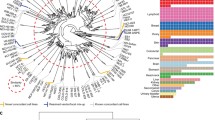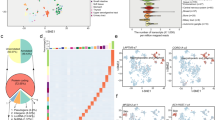Abstract
Purpose
Expression microarrays are powerful technology that allows large-scale analysis of RNA profiles in a tissue; these platforms include underexploited detection scores outputs. We developed an algorithm using the detection score, to generate a detection profile of shared elements in retinoblastoma as well as to determine its transcriptomic size and structure.
Methods
We analyzed eight briefly cultured primary retinoblastomas with the Human transcriptome array 2.0 (HTA2.0). Transcripts and genes detection scores were determined using the Detection Above Background algorithm (DABG). We used unsupervised and supervised computational tools to analyze detected and undetected elements; WebGestalt was used to explore functions encoded by genes in relevant clusters and performed experimental validation.
Results
We found a core cluster with 7,513 genes detected and shared by all samples, 4,321 genes in a cluster that was commonly absent, and 7,681 genes variably detected across the samples accounting for tumor heterogeneity. Relevant pathways identified in the core cluster relate to cell cycle, RNA transport, and DNA replication. We performed a kinome analysis of the core cluster and found 4 potential therapeutic kinase targets. Through analysis of the variably detected genes, we discovered 123 differentially expressed transcripts between bilateral and unilateral cases.
Conclusions
This novel analytical approach allowed determining the retinoblastoma transcriptomic size, a shared active transcriptomic core among the samples, potential therapeutic target kinases shared by all samples, transcripts related to inter tumor heterogeneity, and to determine transcriptomic profiles without the need of control tissues. This approach is useful to analyze other cancer or tissue types.



Similar content being viewed by others
References
Affymetrix (2015) Microarray normalization using signal space transformation with probe guanine cytosine count correction. 2015. https://tools.thermofisher.com/content/sfs/brochures/sst_gccn_whitepaper.pdf
Castro-Magdonel BE, Orjuela M, Camacho J, García-Chéquer AJ, Cabrera-Muñoz L, Sadowinski-Pine S, Durán-Figueroa N et al (2017) MiRNome Landscape analysis reveals a 30 MiRNA core in retinoblastoma. BMC Cancer 17(1):458. https://doi.org/10.1186/s12885-017-3421-3
Chakraborty S, Khare S, Dorairaj SK, Prabhakaran VC, Prakash DR, Kumar A (2007) Identification of genes associated with tumorigenesis of retinoblastoma by microarray analysis. Genomics 90(3):344–353. https://doi.org/10.1016/J.YGENO.2007.05.002
Cieślik M, Chinnaiyan AM (2018) Cancer transcriptome profiling at the juncture of clinical translation. Nature Rev Genet 19(2):93–109. https://doi.org/10.1038/nrg.2017.96
Clark TA, Schweitzer AC, Chen TX, Staples MK, Lu G, Wang H, Williams A, Blume JE (2007) Discovery of tissue-specific exons using comprehensive human exon microarrays. Genome Biol 8(4):R64. https://doi.org/10.1186/gb-2007-8-4-r64
Dimaras H, Corson TW (2018) Retinoblastoma, the visible CNS tumor: a review. J Neurosci Res. https://doi.org/10.1002/jnr.24213
Fabbro D, Cowan-Jacob SW, Moebitz H (2015) Ten things you should know about protein kinases: IUPHAR Review 14. Br J Pharmacol 172(11):2675–2700. https://doi.org/10.1111/bph.13096
Ganguly A, Shields CL (2010) Differential gene expression profile of retinoblastoma compared to normal retina. Molecular Vision 16:1292–1303
Gobin YP (2011) Intra-arterial chemotherapy for the management of retinoblastoma. Arch Ophthalmol 129(6):732. https://doi.org/10.1001/archophthalmol.2011.5
Gregory R. Warnes, Ben Bolker, Lodewijk Bonebakker, Robert Gentleman, Wolfgang Huber Andy Liaw, Thomas Lumley, Martin Maechler, Arni Magnusson, Steffen Moeller MS and BV (2015) Gplots: Various R Programming Tools for Plotting Data. R Package Version 3.0.1.1. https://cran.r-project.org/package=gplots
Gu Z, Gu L, Eils R, Schlesner M, Brors B (2014) Circlize Implements and Enhances Circular Visualization in R. Bioinformatics (Oxford, England) 30(19):2811–2812. https://doi.org/10.1093/bioinformatics/btu393
Harrow J, Frankish A, Gonzalez JM, Tapanari E, Diekhans M, Kokocinski F, Aken BL et al (2012) GENCODE: The reference human genome annotation for The ENCODE project. Genome Res 22(9):1760–1774. https://doi.org/10.1101/gr.135350.111
Haynes WA, Higdon R, Stanberry L, Collins D, Kolker E (2013) Differential Expression Analysis for Pathways. PLoS Computat Biol. https://doi.org/10.1371/journal.pcbi.1002967
Kapatai G, Brundler M-A, Jenkinson H, Kearns P, Parulekar M, Peet AC, Mcconville CM (2013) Gene expression profiling identifies different sub-types of retinoblastoma. Br J Cancer. https://doi.org/10.1038/bjc.2013.283
Kooi IE, Mol BM, Moll AC, van der Valk P, de Jong MC, de Graaf P, van Mil SE et al (2015) Loss of photoreceptorness and gain of genomic alterations in retinoblastoma reveal tumor progression. EBioMedicine 2(7):660–670. https://doi.org/10.1016/J.EBIOM.2015.06.022
Liao Y, Wang J, Jaehnig EJ, Shi Z, Zhang B (2019) WebGestalt 2019: Gene set analysis toolkit with revamped UIs and APIs. Nucleic Acids Res 47(W1):W199–205. https://doi.org/10.1093/nar/gkz401
Liu Y, Zhong X, Wan S, Zhang W, Lin J, Zhang P, Li Y (2014) P16INK4a Expression in retinoblastoma: a marker of differentiation grade. Diagn Pathol 9(1):180. https://doi.org/10.1186/s13000-014-0180-1
Manning G, Whyte DB, Martinez R, Hunter T, Sudarsanam S (2002) The protein kinase complement of the human genome. Science. https://doi.org/10.1126/science.1075762
McEvoy J, Flores-Otero J, Zhang J, Nemeth K, Brennan R, Bradley C, Krafcik F et al (2011) Coexpression of normally incompatible developmental pathways in retinoblastoma genesis. Cancer Cell 20(2):260–275. https://doi.org/10.1016/J.CCR.2011.07.005
Mejía-Pedroza RA, Espinal-Enríquez J, Hernández-Lemus E (2018) Pathway-based drug repositioning for breast cancer molecular subtypes. Front Pharmacol. https://doi.org/10.3389/fphar.2018.00905
Okoniewski MJ, Miller CJ (2008) Comprehensive analysis of affymetrix exon arrays using BioConductor. PLoS Comput Biol. https://doi.org/10.1371/journal.pcbi.0040006
Orjuela MA, Cabrera-Muñoz L, Paul L, Ramirez-Ortiz MA, Liu X, Chen J, Mejia-Rodriguez F et al (2012) Risk of retinoblastoma is associated with a maternal polymorphism in dihydrofolatereductase (DHFR) and prenatal folic acid intake. Cancer 118(23):5912–5919. https://doi.org/10.1002/cncr.27621
Pawluczyk M, Weiss J, Links MG, Egaña Aranguren M, Wilkinson MD, Egea-Cortines M (2015) Quantitative evaluation of bias in PCR amplification and next-generation sequencing derived from metabarcoding samples. Anal Bioanal Chem 407(7):1841–1848. https://doi.org/10.1007/s00216-014-8435-y
Plomin R, Schalkwyk LC (2007) Microarrays. Developm Sci 10(1):19–23. https://doi.org/10.1111/j.1467-7687.2007.00558.x
R Core Team (2019) R: A language and environment for statistical computing. R Foundation for Statistical Computing, Vienna, Austria. 2019. https://www.r-project.org/
Ritchie ME, Phipson B, Wu D, Hu Y, Law CW, Shi W, Smyth GK (2015) Limma powers differential expression analyses for RNA-sequencing and microarray studies. Nucleic Acids Res 43(7):e47–e47. https://doi.org/10.1093/nar/gkv007
Romero JP, Ortiz-Estévez M, Muniategui A, Carrancio S, De MFJ, Carazo F, Montuenga LM et al (2018) Comparison of RNA-Seq and microarray platforms for splice event detection using a cross-platform algorithm. BMC Genomics 19(1):703. https://doi.org/10.1186/s12864-018-5082-2
Roskoski R (2019) Properties of FDA-approved small molecule protein kinase inhibitors Pharmacological Research. Academic Press 10.1016/j.phrs.2019.03.006
Shields CL, Bianciotto CG, Jabbour P, Ramasubramanian A, Lally SE, Griffin GC, Rosenwasser R, Shields JA (2011) Intra-arterial chemotherapy for retinoblastoma. Arch Ophthalmol 129(11):1399. https://doi.org/10.1001/archophthalmol.2011.150
Tarca AL, Romero R, Draghici S (2006) Analysis of microarray experiments of gene expression profiling. Am J Obstet Gynecol 195(2):373–388. https://doi.org/10.1016/j.ajog.2006.07.001
Van Dijk EL, Jaszczyszyn Y, Thermes C (2014) Library preparation methods for next-generation sequencing: tone down the bias. Academic Press Inc, Cambridge, Experim Cell Res. https://doi.org/10.1016/j.yexcr.2014.01.008
Weijun L, Cory B (2013) Pathview: An R/Bioconductor package for pathway-based data integration and visualization. Bioinformatics 29(14):1830–1831. https://doi.org/10.1093/bioinformatics/btt285
Zhang W, Yu Y, Hertwig F, Thierry-Mieg J, Zhang W, Thierry-Mieg D, Wang J et al (2015) Comparison of RNA-Seq and microarray-based models for clinical endpoint prediction. Genome Biol 16(1):133. https://doi.org/10.1186/s13059-015-0694-1
Acknowledgements
We thank Microarray Core Facility at INMEGEN for experimental support, and Dra. Laura Gómez for valuable technical suggestions.
Funding
This work has been funded by IMSS grant R2015-785-049 and NIH grants CA167833, CA192662, CA98180 (MO) and scholarship by CONACYT to DEAS 407869.
Author information
Authors and Affiliations
Contributions
DEAS, HT, algorithm design, programing, analysis, EHL outstanding bioinformatics support. MO clinical design and critical reading of the manuscript; MLCM and SSP tissue procurement and histopathological evaluations; AHA tumor tissue primary cultures; JC and LF validation design and facilities support; MVPC, RNA extraction overall study design, data interpretation, DEAS performed experimental validation, DEAS, HT and MVPC wrote the manuscript. All authors revised and approved the final manuscript.
Corresponding author
Ethics declarations
Conflict of interest
The authors declare no competing interest.
Ethics approval and consent to participate
Ethical considerations involved in this study have been addressed according to the Helsinki Declaration 2013. All Samples were obtained after parental informed consent to participate in a larger IRB approved case–control study. This study was approved by Comisión Nacional de Investigación Científica IMSS R2012-785–039 and Comisión de bioética y bioseguridad HIM/2012/054). It includes Rb patients treated at Hospital de Pediatría, at Centro Médico Nacional from Instituto Mexicano del Seguro Social (IMSS) and Hospital Infantil de México Federico Gómez in Mexico City.
Consent for publication
Not applicable.
Availability of data and materials
The data sets are available in NCBI’s Gene Expression Omnibus repository. Accession number GSE141209 https://www.ncbi.nlm.nih.gov/geo/query/acc.cgi?acc=GSE141209.
Code availability
The R script is available upon request.
Additional information
Publisher's Note
Springer Nature remains neutral with regard to jurisdictional claims in published maps and institutional affiliations.
Electronic supplementary material
Below is the link to the electronic supplementary material.
Rights and permissions
About this article
Cite this article
Alvarez-Suarez, D.E., Tovar, H., Hernández-Lemus, E. et al. Discovery of a transcriptomic core of genes shared in 8 primary retinoblastoma with a novel detection score analysis. J Cancer Res Clin Oncol 146, 2029–2040 (2020). https://doi.org/10.1007/s00432-020-03266-y
Received:
Accepted:
Published:
Issue Date:
DOI: https://doi.org/10.1007/s00432-020-03266-y




